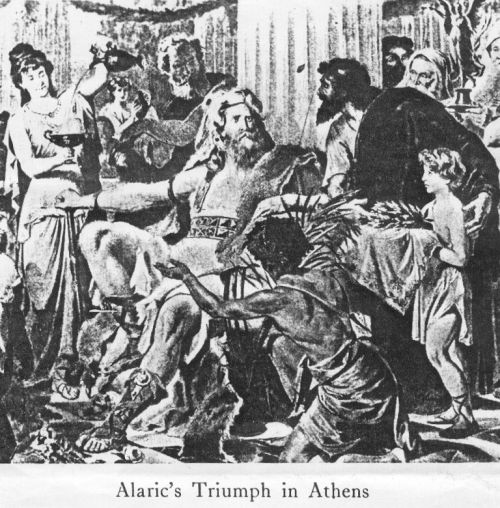
FALL OF ROME PART II
The Collapse of the Roman Empire
In December 406 AD a group of Germanic tribes entered Gaul and settled there. The Romans were unable to stop them. Nevertheless at first the Germanic settlers accepted Roman rule. However as the Roman Empire broke down they gradually formed independent kingdoms
Barbarians in France callled GAULS

Clovis also issued a body of laws called Salic law and in 507 AD he made the little town of Paris his capital. (Towns in Gaul shrank in the 5th century with the collapse of Roman rule but they did not disappear entirely).
Clovis also subdued parts of southern France. After his death in 511 at the age of 45 his descendants continued his work and by the mid-6th century the Franks ruled all of France.
Charles Martel halted the Islamic advance into Europe at the battle of Poitiers in 732. He also defeated the Bavarians and the Saxons. His son Charlemagne carried on his work and created a great European empire. He also forced pagan Germans to 'convert' to Christianity. Finally in 800 AD the Pope crowned Charlemagne Emperor. Thus Charlemagne claimed to be the successor of the old Roman Emperors.
Barbarians in SpainCcalled VANDALS

However another Germanic people, the Visigoths became allies of the Romans. In 416-418 they invaded Spain. They defeated the Alans but then withdrew into France. The Vandals then absorbed the remaining Alans but in 429 they crossed to North Africa leaving Spain to the Sueves.
However the Visigoth king Theoderic II (453-466) led an army into Spain and in 456 he crushed the Sueves in battle. Most of Spain came under the rule of the Visigoths.
After 409 one small part of Northeast Spain was left under Roman control. However in 476 the Visigoths took it over.
Under the Visigoths the old Roman towns continued to decline and their populations fell. On the other hand in 587 King Reccared became a Catholic and in 654 King Recceswinth made a single code of law for his kingdom.
Nevertheless the Visigoth kings were never very strong. The Visigoth kingdom suffered from internal divisions and in the end it was easy prey for the Moors.
In the 7th century the Visigoths also persecuted Jews. (There were many Jews in Spain from the time of the Romans onward).
However at the beginning of the 8th century the Visigoth realm was destroyed by a Muslim invasion. In 711 an army of Berbers from North Africa, led by Arabs crossed to Spain and they utterly defeated the Visigoths at the Barbate River on 19 July 711.
Barbarians in ItalyCALLED gOTHS

However for most people in Italy life went on as usual. The Germanic kings respected Roman culture and laws.
Odoacer was followed by Theodoric the Ostrogoth in 493. He ruled until 526 and under him Germans and Romans lived together peacefully.
Meanwhile the eastern half of the Roman empire was still flourishing. It was now called the Byzantine empire. In 535 the Byzantine emperor Justinian sent an army to Italy under his general Belisarius. So began a long period of warfare which devastated much of Italy.
Belisarius marched north through Italy and he captured Ravenna in 540. However under their leader Totila (541-552) the Goths recaptured most of Italy. Only Ravenna and some other coastal towns stayed in Byzantine hands. The Pendulum then swung the other way. Under their general Narses the Byzantines took all of Italy again by 562.
Then in 568 barbarians called the Lombards invaded north Italy. Under their leaders Authari (584-590) and Agilulf (590-616) the Lombards fought their way south but they were halted by the Byzantines at a line from Ravenna to Rome. Gradually the Lombards intermarried with the native Italians and they also adopted Italian customs. They also adopted the Italian language.
.

Alaric
At its height the Roman Empire stretched from Britain and the Atlantic to North Africa and Mesopotamia. In the fourth century AD, however, what Pliny the Elder had called the ‘immense majesty of the Roman peace’ was menaced by invasions of Germanic peoples from beyond the frontiers of the Rhine and the Danube. Among them were the Visigoths, whose leader from around 395 was a chieftain in his mid-20s named Alaric. That same year also saw the death of the Emperor Theodosius the Great, after which the Roman
n the summer of 376 A.D., an immense crowd of refugees arrived on the banks of Rome’s Danube frontier. Known as the Goths, they were mostly organized into two politically organized groups: the Tervingi and the Greuthungi, each with around ten thousand warriors.

Walang komento:
Mag-post ng isang Komento